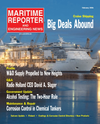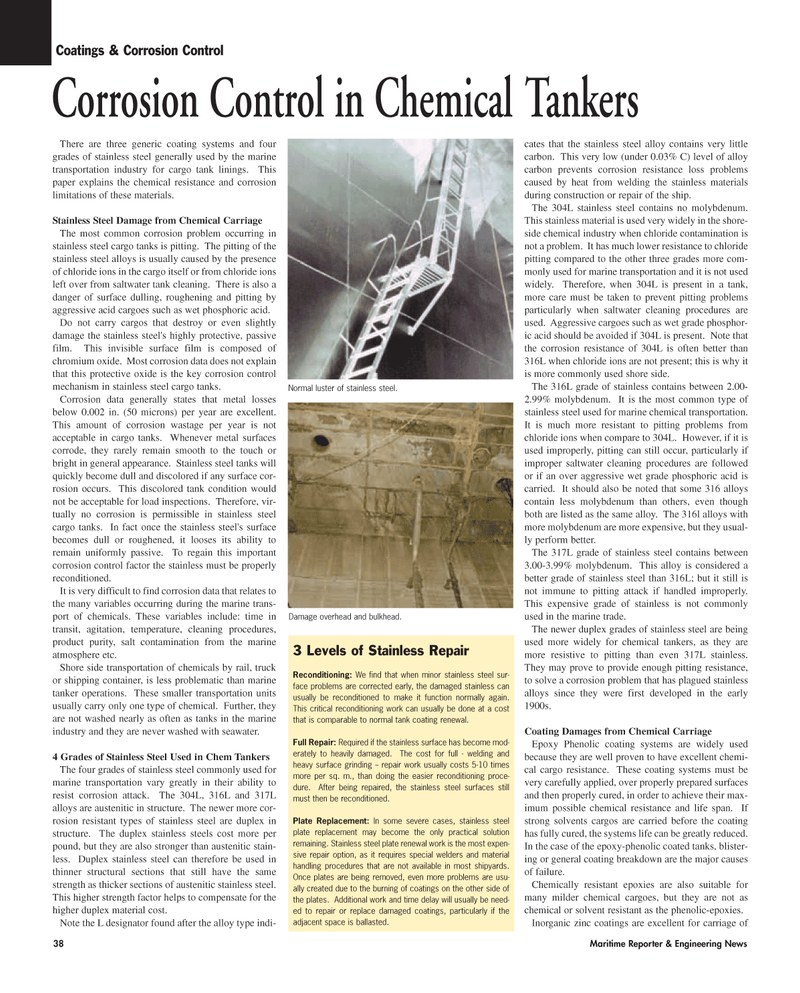
Page 38: of Maritime Reporter Magazine (February 2, 2006)
Read this page in Pdf, Flash or Html5 edition of February 2, 2006 Maritime Reporter Magazine
38 Maritime Reporter & Engineering News
Coatings & Corrosion Control
There are three generic coating systems and four grades of stainless steel generally used by the marine transportation industry for cargo tank linings. This paper explains the chemical resistance and corrosion limitations of these materials.
Stainless Steel Damage from Chemical Carriage
The most common corrosion problem occurring in stainless steel cargo tanks is pitting. The pitting of the stainless steel alloys is usually caused by the presence of chloride ions in the cargo itself or from chloride ions left over from saltwater tank cleaning. There is also a danger of surface dulling, roughening and pitting by aggressive acid cargoes such as wet phosphoric acid.
Do not carry cargos that destroy or even slightly damage the stainless steel's highly protective, passive film. This invisible surface film is composed of chromium oxide. Most corrosion data does not explain that this protective oxide is the key corrosion control mechanism in stainless steel cargo tanks.
Corrosion data generally states that metal losses below 0.002 in. (50 microns) per year are excellent.
This amount of corrosion wastage per year is not acceptable in cargo tanks. Whenever metal surfaces corrode, they rarely remain smooth to the touch or bright in general appearance. Stainless steel tanks will quickly become dull and discolored if any surface cor- rosion occurs. This discolored tank condition would not be acceptable for load inspections. Therefore, vir- tually no corrosion is permissible in stainless steel cargo tanks. In fact once the stainless steel's surface becomes dull or roughened, it looses its ability to remain uniformly passive. To regain this important corrosion control factor the stainless must be properly reconditioned.
It is very difficult to find corrosion data that relates to the many variables occurring during the marine trans- port of chemicals. These variables include: time in transit, agitation, temperature, cleaning procedures, product purity, salt contamination from the marine atmosphere etc.
Shore side transportation of chemicals by rail, truck or shipping container, is less problematic than marine tanker operations. These smaller transportation units usually carry only one type of chemical. Further, they are not washed nearly as often as tanks in the marine industry and they are never washed with seawater. 4 Grades of Stainless Steel Used in Chem Tankers
The four grades of stainless steel commonly used for marine transportation vary greatly in their ability to resist corrosion attack. The 304L, 316L and 317L alloys are austenitic in structure. The newer more cor- rosion resistant types of stainless steel are duplex in structure. The duplex stainless steels cost more per pound, but they are also stronger than austenitic stain- less. Duplex stainless steel can therefore be used in thinner structural sections that still have the same strength as thicker sections of austenitic stainless steel.
This higher strength factor helps to compensate for the higher duplex material cost.
Note the L designator found after the alloy type indi- cates that the stainless steel alloy contains very little carbon. This very low (under 0.03% C) level of alloy carbon prevents corrosion resistance loss problems caused by heat from welding the stainless materials during construction or repair of the ship.
The 304L stainless steel contains no molybdenum.
This stainless material is used very widely in the shore- side chemical industry when chloride contamination is not a problem. It has much lower resistance to chloride pitting compared to the other three grades more com- monly used for marine transportation and it is not used widely. Therefore, when 304L is present in a tank, more care must be taken to prevent pitting problems particularly when saltwater cleaning procedures are used. Aggressive cargoes such as wet grade phosphor- ic acid should be avoided if 304L is present. Note that the corrosion resistance of 304L is often better than 316L when chloride ions are not present; this is why it is more commonly used shore side.
The 316L grade of stainless contains between 2.00- 2.99% molybdenum. It is the most common type of stainless steel used for marine chemical transportation.
It is much more resistant to pitting problems from chloride ions when compare to 304L. However, if it is used improperly, pitting can still occur, particularly if improper saltwater cleaning procedures are followed or if an over aggressive wet grade phosphoric acid is carried. It should also be noted that some 316 alloys contain less molybdenum than others, even though both are listed as the same alloy. The 316l alloys with more molybdenum are more expensive, but they usual- ly perform better.
The 317L grade of stainless steel contains between 3.00-3.99% molybdenum. This alloy is considered a better grade of stainless steel than 316L; but it still is not immune to pitting attack if handled improperly.
This expensive grade of stainless is not commonly used in the marine trade.
The newer duplex grades of stainless steel are being used more widely for chemical tankers, as they are more resistive to pitting than even 317L stainless.
They may prove to provide enough pitting resistance, to solve a corrosion problem that has plagued stainless alloys since they were first developed in the early 1900s.
Coating Damages from Chemical Carriage
Epoxy Phenolic coating systems are widely used because they are well proven to have excellent chemi- cal cargo resistance. These coating systems must be very carefully applied, over properly prepared surfaces and then properly cured, in order to achieve their max- imum possible chemical resistance and life span. If strong solvents cargos are carried before the coating has fully cured, the systems life can be greatly reduced.
In the case of the epoxy-phenolic coated tanks, blister- ing or general coating breakdown are the major causes of failure.
Chemically resistant epoxies are also suitable for many milder chemical cargoes, but they are not as chemical or solvent resistant as the phenolic-epoxies.
Inorganic zinc coatings are excellent for carriage of
Corrosion Control in Chemical Tankers
Normal luster of stainless steel.
Damage overhead and bulkhead. 3 Levels of Stainless Repair
Reconditioning: We find that when minor stainless steel sur- face problems are corrected early, the damaged stainless can usually be reconditioned to make it function normally again.
This critical reconditioning work can usually be done at a cost that is comparable to normal tank coating renewal.
Full Repair: Required if the stainless surface has become mod- erately to heavily damaged. The cost for full - welding and heavy surface grinding -- repair work usually costs 5-10 times more per sq. m., than doing the easier reconditioning proce- dure. After being repaired, the stainless steel surfaces still must then be reconditioned.
Plate Replacement: In some severe cases, stainless steel plate replacement may become the only practical solution remaining. Stainless steel plate renewal work is the most expen- sive repair option, as it requires special welders and material handling procedures that are not available in most shipyards.
Once plates are being removed, even more problems are usu- ally created due to the burning of coatings on the other side of the plates. Additional work and time delay will usually be need- ed to repair or replace damaged coatings, particularly if the adjacent space is ballasted.
MR FEBRUARY2006 #5 (33-40).qxd 2/1/2006 7:57 PM Page 38

 37
37

 39
39
